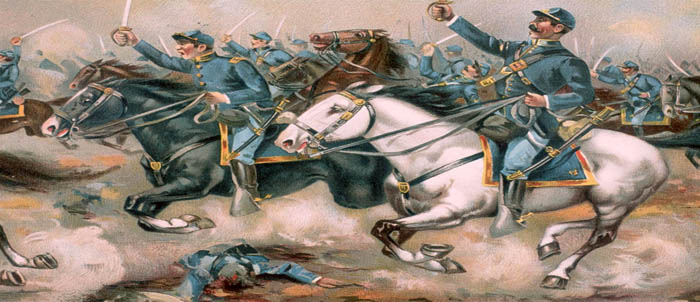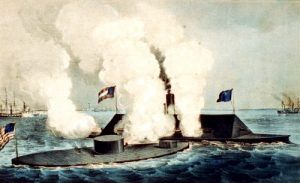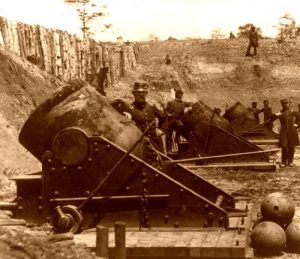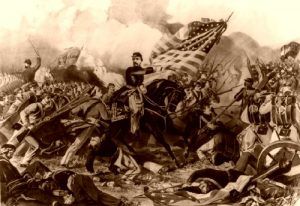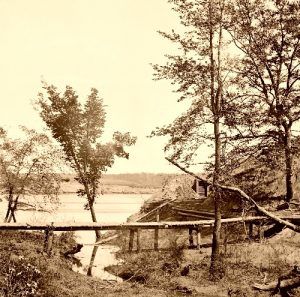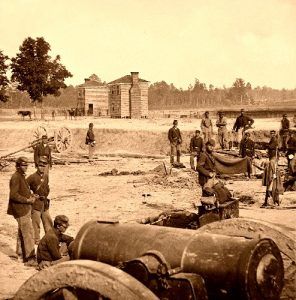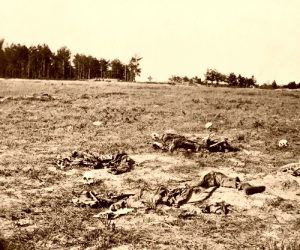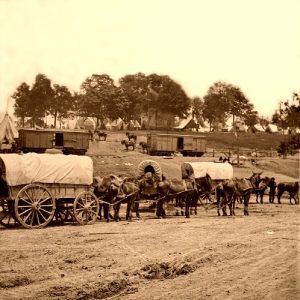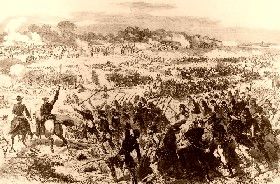The Peninsula Campaign, also known as the Peninsular Campaign, was a Union offensive from March through July 1862 during the Civil War. Intending to capture the Confederate capital of Richmond, Virginia, it was the first large-scale offensive in the Eastern Theater. The strategic concept was the brainchild of Union Army Commander-in-Chief Major General George B. McClellan, who felt his Army of the Potomac could avoid high casualties by not marching south on Richmond from northern Virginia but rather by moving by water. After moving his troops by boat to Fort Monroe in late April, McClellan planned an advance toward Richmond via the peninsula formed by the York and James Rivers. McClellan was initially successful against the equally cautious General Joseph E. Johnston. Still, the emergence of the more aggressive General Robert E. Lee turned the subsequent Seven Days Battles into a humiliating Union defeat. Losses during the campaign were significant, with Union casualties of 23,119 and 29,298 Confederate.
Hampton Roads (March 8-9, 1862) – Also referred to as the Monitor vs. Merrimack or the Battle of the Ironclads, this skirmish took place on March 8th and 9th, 1862, at Hampton Roads, Virginia. Involving four U.S. and one Confederate warship, the principal commanders were Lieutenant John Wordon and Captain Franklin Buchanan for the Union and Lieutenant Catesby R. Jones for the South. On March 8, 1862, from her berth at Norfolk, the Confederate ironclad Virginia steamed into Hampton Roads, where she sank the Cumberland and ran the Congress aground. On March 9, the Union ironclad Monitor, having fortuitously arrived to fight, initiated ironclads’ first engagement in history. The two ships fought each other to a standstill, but Virginia retired. The battle resulted in an estimated 433 casualties, of which 409 were Union and 24 were Confederate.
Yorktown (April 5-May 4, 1862) – The Yorktown battle took place in York County and Newport News, Virginia, from April 5 to May 4, 1862. Marching from Fort Monroe, Major General George B. McClellan’s army encountered Major General John B. Magruder’s small Confederate army at Yorktown behind the Warwick River. Magruder’s theatrics convinced the Federals that his works were firmly held. McClellan suspended the march up the Peninsula toward Richmond, ordered the construction of siege fortifications, and brought his heavy siege guns to the front. In the meantime, General Joseph E. Johnston brought reinforcements for Magruder. On April 16, Union forces probed a Confederate line weakness at Lee’s Mill or Dam No. 1, resulting in about 309 casualties.
However, failure to exploit this attack’s initial success held up McClellan for two additional weeks while trying to convince his navy to maneuver the Confederates’ big guns at Yorktown and Gloucester Point and ascend the York River to West Point, thus outflanking the Warwick Line. McClellan planned for a massive bombardment to begin at dawn on May 4, but the Confederate Army slipped away in the night toward Williamsburg. Casualties during the battle were estimated at 320.
Additional Information:
Colonial National Historical Park
P.O. Box 210
Yorktown, Virginia 23690
757-898-2410
Williamsburg (May 5, 1862) – Also called the Battle of Fort Magruder, the conflict occurred in Williamsburg, Virginia, on May 5, 1862. In the first pitched battle of the Peninsula Campaign, nearly 41,000 Federals and 32,000 Confederates were engaged. Following up the Confederate retreat from Yorktown, Hooker’s division encountered the Confederate rearguard near Williamsburg. Hooker assaulted Fort Magruder, an earthen fortification alongside the Williamsburg Road, but was repulsed. Confederate counterattacks, directed by Major General James Longstreet, threatened to overwhelm the Union left flank until Kearny’s division arrived to stabilize the Federal position. Hancock’s brigade then moved to threaten the Confederate left flank, occupying two abandoned redoubts.
The Confederates counterattacked unsuccessfully. Hancock’s localized success was not exploited. The army continued its withdrawal during the night. Of more than 72,000 troops engaged, the estimated casualties were 3,843, 2,283 of which were Union and 1,560 Confederate.
Additional Information:
Colonial National Historical Park
P.O. Box 210
Yorktown, Virginia 23690
757-898-2410
Eltham’s Landing (May 7, 1862) – Also referred to as the Battle of Barhamsville or West Point, this skirmish took place in New Kent County, Virginia, on May 7, 1862. When Union Brigadier General William B. Franklin’s division landed at Eltham’s Landing, they were attacked by two brigades of Major General Gustavus W. Smith’s command, reacting to the threat to the Confederate army’s trains on the Barhamsville Road. Franklin’s movement occurred while the Confederate army withdrew from the Williamsburg line. Estimated casualties were 242 – 194 Union and 48 Confederate.
Drewry’s Bluff (May 15, 1862) – Also called the Battle of Fort Darling or Fort Drewry, this conflict occurred in Chesterfield County, Virginia, on May 15, 1862. With the fall of Yorktown, the Confederate ironclad Virginia at Norfolk was scuttled to prevent her capture. This opened the James River to Federal gunboats. On May 15, five gunboats, including Monitor and Galena’s ironclads, steamed up the James River to test the Richmond defenses. They encountered submerged obstacles and deadly accurate fire from the batteries at Drewry’s Bluff, severely damaging the Galena. The Federal Navy was turned back. The Confederate victor resulted in estimated total casualties of 41.
Hanover Court House (May 27, 1862) – Sometimes referred to as the Slash Church Battle, this confrontation occurred in Hanover County, Virginia, on May 27, 1862. On that day, elements of Brigadier General Fitz John Porter’s V Corps extended north to protect the right flank of McClellan’s Union army that now straddled the Chickahominy River. Porter’s objective was to cut the railroad and open the Telegraph Road for Union reinforcements under Major General Irvin McDowell marching south from Fredericksburg. Under the command of Brigadier General Lawrence O’Bryan Branch, Confederate forces attempting to prevent this maneuver were defeated just south of Hanover Courthouse after a stiff fight. However, the Union victory was moot, for McDowell’s reinforcements were recalled to Fredericksburg upon word of Banks’ rout at First Winchester. In the end, some 1,327 were dead, including 397 Union men and 930 Confederates.
Seven Pines (May 31-June 1, 1862) – Also called the Battle of Fair Oaks or Fair Oaks Station, the encounter occurred in Henrico County, Virginia, on May 31 and June 1, 1862. On May 31, Confederate General Joseph E. Johnston attempted to overwhelm two Federal corps, under the command of Major General George B. McClellan, that appeared isolated south of the Chickahominy River. The Confederate assaults, though not well coordinated, succeeded in driving back the IV Corps and inflicting heavy casualties. Reinforcements arrived, and both sides fed more and more troops into the action. Supported by the III Corps and Sedgwick’s division of Sumner’s II Corps (that crossed the rain-swollen river on Grapevine Bridge), the Federal position was finally stabilized. General Johnston was seriously wounded during the action, and command of the Confederate army devolved temporarily to Major General G.W. Smith.
On June 1, the Confederates renewed their assaults against the Federals, who had brought up more reinforcements but made little headway. Both sides claimed victory. Confederate brigadier Robert H. Hatton was killed. Of the approximately 84,000 men engaged, the Union lost approximately 5,738, and the Confederate, 7,997.
Oak Grove (June 25, 1862) – Also known as the Battle of French’s Field or King’s School House, this event occurred in Henrico County. The first of the Seven Days’ battles began on June 25 when Major General George B. McClellan advanced his lines along the Williamsburg Road to bring Richmond within range of his siege guns. Union forces attacked over the swampy ground with inconclusive results, and darkness halted the fighting. McClellan’s attack was not strong enough to derail Confederate General Robert E. Lee, already set in motion. The next day, Lee seized the initiative by attacking Beaver Dam Creek north of the Chickahominy. In the end, 516 federal soldiers lost their lives, as well as 541 Confederates.
Additional Information:
Richmond National Battlefield Park
3215 East Broad Street
Richmond, Virginia 23223
804-226-1981 ext. 23
Beaver Dam Creek (June 26, 1862) – Also referred to as Mechanicsville and Ellerson’s Mill, this second of the Seven Days’ Battles took place in Hanover County, Virginia, on June 26, 1862. General Robert E. Lee initiated his offensive against McClellan’s right flank north of the Chickahominy River. A.P. Hill threw his division, reinforced by one of D.H. Hill’s brigades, into a series of futile assaults against Brigadier General Fitz John Porter’s V Corps, drawn up behind Beaver Dam Creek. Confederate attacks were driven back with heavy casualties. However, Jackson’s Shenandoah Valley divisions were approaching from the northwest, forcing Porter to withdraw to a position behind Boatswain Creek just beyond Gaines’ Mill the following day. With almost 32,000 troops engaged, the battle resulted in a Union victory, with a loss of 400 federal men and 1,300 Confederates.
Additional Information:
Richmond National Battlefield Park
3215 East Broad Street
Richmond, Virginia 23223
804-226-1981 ext. 23
Gaines’ Mill (June 27, 1862) – Also called the First Battle of Cold Harbor, this Confederate Victory was the third of the Seven Days Battles. General Robert E. Lee renewed his attacks against Brigadier General Fitz John Porter’s V Corps, establishing a solid defensive line behind Boatswain’s Swamp north of the Chickahominy River. Porter’s reinforced V Corps held fast for the afternoon against disjointed Confederate attacks, inflicting heavy casualties. At dusk, the Confederates finally mounted a coordinated assault that broke Porter’s line and drove his soldiers back toward the river. The Federals retreated across the river during the night. Defeat at Gaines’ Mill convinced McClellan to abandon his advance on Richmond and begin the James River retreat. Gaines’ Mill saved Richmond for the Confederacy in 1862. This large battle encompassed more than 90,000 troops, of which 6,800 Union and 8.700 Confederates lost their lives.
Additional Information:
Richmond National Battlefield Park
3215 East Broad Street
Richmond, Virginia 23223
804-226-1981 ext. 23
Garnett’s & Golding’s Farms (June 27-28, 1862) Taking place in Henrico County, Virginia, Major General George B. McClellan, and Major General John B. Magruder continued the Seven Days Battles. While the battle raged north of the Chickahominy River at Gaines’ Mill on June 27, Magruder demonstrated against the Union line south of the river at Garnett’s Farm. The Federal defenders from Major General Samuel P. Heintzelman’s III Corps refused their line along the river to escape an artillery crossfire. The Confederates attacked again near Golding’s Farm on the morning of June 28 but were easily repulsed. These “fixing” actions heightened the Union high command’s fear that an all-out attack would be launched against them south of the river. An estimated 830 total lives were lost in the skirmish.
Savage’s Station (June 29, 1862) – Taking place in Henrico County, Virginia, the Savage Station battle was yet another in the Seven Days Battles. On June 29, the Union army’s main body began a general withdrawal toward the James River. Confederate Major General John Magruder pursued along the railroad and the Williamsburg Road and struck Major General Edwin Sumner Corps (the Union rearguard) with three brigades near Savage’s Station. Confederate Brigadier General Richard Griffith was mortally wounded during the fight. Jackson’s divisions were stalled north of the Chickahominy. Union forces continued to withdraw across White Oak Swamp, abandoning supplies and more than 2,500 wounded soldiers in a field hospital. When the smoke cleared, some 4,700 men were dead, and the 2,500 federal wounded were captured.
White Oak Swamp (June 30, 1862) – The following day, also in Henrico County, the White Oak Swamp battle took place between Union Major General William Franklin and Confederate Major General Thomas Jonathan “Stonewall” Jackson’s forces. Union rearguard under Major General William Franklin stopped Jackson’s divisions at the White Oak Bridge crossing, resulting in an artillery duel. At the same time, the main battle raged two miles farther south at Glendale or Frayser’s Farm. White Oak Swamp can be considered part of the Glendale engagement. In the end, 500 men were dead.
Glendale (June 30, 1862) – Known by several names, including Nelson’s Farm, Frayser’s Farm, Charles City Crossroads, White Oak Swamp, New Market Road, Riddell’s Shop, this skirmish occurred on the same date as the White Oak conflict, also in Henrico County. On June 30, Huger’s, Longstreet’s, and A.P. Hill’s divisions converged on the retreating Union army near Glendale or Frayser’s Farm. Longstreet’s and Hill’s attacks penetrated the Union defense near Willis Church, routing McCall’s division. McCall was captured. Union counterattacks by Hooker’s and Kearny’s divisions sealed the break and saved their line of retreat along Willis Church Road. Huger’s advance was stopped on Charles City Road. Franklin delayed “Stonewall” Jackson’s divisions at White Oak Swamp.
Confederate Major General T.H. Holmes made a feeble attempt to turn the Union left flank at Turkey Bridge but was driven back by Federal gunboats in James River. Union generals Meade and Sumner and Confederate generals Anderson, Pender, and Featherston were wounded. This was Lee’s best chance to cut off the Union army from the James River. That night, McClellan established a strong position on Malvern Hill. The total loss was an estimated 6,500.
Additional Information:
Richmond National Battlefield Park
3215 East Broad Street
Richmond, Virginia 23223
804-226-1981 ext. 23
Malvern Hill (July 1, 1862) – The last of the Seven Days Battles, this encounter is sometimes referred to as Poindexter’s Farm. On July 1, 1862, General Robert E. Lee launched a series of disjointed assaults on the nearly impregnable Union position on Malvern Hill. The Confederates suffered more than 5,300 casualties without gaining an inch of ground. Despite his victory, McClellan withdrew to entrench at Harrison’s Landing on James River, where gunboats protected his army. This ended the Peninsula Campaign. When McClellan’s army ceased to threaten Richmond, Lee sent “Stonewall” Jackson to operate against Major General John Pope’s army along the Rapidan River, thus initiating the Northern Virginia Campaign. The Union victory resulted in a loss of 8,500 lives.
Additional Information:
Richmond National Battlefield Park
3215 East Broad Street
Richmond, Virginia 23223
804-226-1981 ext. 23
Compiled and edited by Kathy Alexander/Legends of America, updated January 2023.
Sources:
Battlefields.org
National Park Service Battle Descriptions (no longer available online)
National Park Service Civil War
Wikipedia

